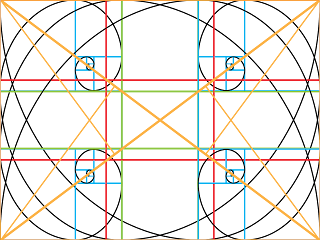News and updates about my artwork, tutorials, thoughts and other cool stuff.
Monday, October 7, 2013
A little update and a question
Hey Everyone, I will have some new posts soon but at the moment I am swamped with work, especially now that I am busy getting a full tabletop RPG book illustrated. Most of the content that I place up on this blog is either about my art or my insights about art in the form of tutorials or opinions. What I would like to know is what kind of content you would like to see about art on this blog? Are there certain tutorials you would like to know or is there anything about my experience as a concept or freelance artist you would like to know? Please feel free to comment.
Monday, September 2, 2013
Ready to be a Spook?

 I am proud to announce that I am part of a new and upcoming tabletop roleplaying game called Spooks Welcome to the Great Beyond by Nathan Reese Maher. Spooks is a family friendly RPG that is easy to learn and is set in the afterlife, but the afterlife isn't what we expected at all! The game can be learned in a manner of minutes but offer hundreds upon hundreds of hours of game play. In Spooks you can play a variety of spirits and undead which include Bhoots, Dolls, Ghosts, Vampires and much much more. While playing these unearthly characters you can have them socialize in the great city of Necropolis, call out to the Spirit Realm for knowledge, or explore the Dream Realm for riches. My role in this game is that of the primary artist, but I have also help shaped the game. However, art is never free and Nathan needs your help in getting the funds to afford the art that he wants in the book for a quality gaming product.
I am proud to announce that I am part of a new and upcoming tabletop roleplaying game called Spooks Welcome to the Great Beyond by Nathan Reese Maher. Spooks is a family friendly RPG that is easy to learn and is set in the afterlife, but the afterlife isn't what we expected at all! The game can be learned in a manner of minutes but offer hundreds upon hundreds of hours of game play. In Spooks you can play a variety of spirits and undead which include Bhoots, Dolls, Ghosts, Vampires and much much more. While playing these unearthly characters you can have them socialize in the great city of Necropolis, call out to the Spirit Realm for knowledge, or explore the Dream Realm for riches. My role in this game is that of the primary artist, but I have also help shaped the game. However, art is never free and Nathan needs your help in getting the funds to afford the art that he wants in the book for a quality gaming product. 
This is where you can help, Nathan has started a kickstarter campaign with a minimum goal of only $3,000 but with a high goal of $13,000. The more that is donated the more art he can afford. For those of you who don't know Kickstarter is a fundraising campaign in which the general public can help by donating through their credit cards. Whatever you donate is not taken off your credit card until the both the goal is achieved and fundraising campaign is finished so it makes it fair for both sides. Help us by becoming a spooky backer and also help spread the word on your networking sites such as Facebook, Twitter, and so on.
Ways to Pay!
Normally payments are made to the Kickstarter Campaign through amazon which requires a creditcard, but did you know that a debit card with a sharecheck option on it will work just as well? Yes that is right you can use your debit card if it has one of those small Visa or Mastercard logos on it. Don't have a creditcard or a sharechek debit card? Then you can always pick up a prepaid credit card at Walmart or other fine stores which work just as well! So don't delay, help support our kickstarter today!
Help Show Your Support!
The Setting

 The Setting of Spooks is of course set in the afterlife and it is a amalgamation of many if not all different cultural beliefs but with it's own unique foundation of what its society is like and has a strong emphasis on Egyptian lore. However, when the book is finished there will be a chapter about storytelling and in this chapter you will find that there can be more than one great beyond, so the setting will be very flexible to play the game YOU want to play! This allows you to have different flavors of campaign approaches. Perhaps you want to play a game similar to the movie Beatlejuice or maybe you want something closer to how the afterlife is in the movie Frighteners and have haunt or hunt haunt fest? Or perhaps you want something a little more Lovecraftian?
The Setting of Spooks is of course set in the afterlife and it is a amalgamation of many if not all different cultural beliefs but with it's own unique foundation of what its society is like and has a strong emphasis on Egyptian lore. However, when the book is finished there will be a chapter about storytelling and in this chapter you will find that there can be more than one great beyond, so the setting will be very flexible to play the game YOU want to play! This allows you to have different flavors of campaign approaches. Perhaps you want to play a game similar to the movie Beatlejuice or maybe you want something closer to how the afterlife is in the movie Frighteners and have haunt or hunt haunt fest? Or perhaps you want something a little more Lovecraftian? 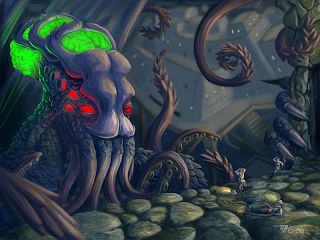 In fact, we have plans that will be . . . infecting . . . Lovecraftian lore into the world of Spooks and it is something that I will be having a personal hand in creating; the void holds many dark mysteries that even drive the dead mad!
In fact, we have plans that will be . . . infecting . . . Lovecraftian lore into the world of Spooks and it is something that I will be having a personal hand in creating; the void holds many dark mysteries that even drive the dead mad! The Races
 Bhoots: One of the undead races you can play in Spooks are the Bhoots. Bhoots are corporeal undead who died in a tragic death or who were murdered. They are hard to track because their foot prints are backwards, they can summon ghost fire which can provide light but can also set things quickly on fire and they can also handle incorporeal objects that normally can only be handled by spooks like ghosts and wraiths.
Bhoots: One of the undead races you can play in Spooks are the Bhoots. Bhoots are corporeal undead who died in a tragic death or who were murdered. They are hard to track because their foot prints are backwards, they can summon ghost fire which can provide light but can also set things quickly on fire and they can also handle incorporeal objects that normally can only be handled by spooks like ghosts and wraiths.Dolls: Another race of undead that you can play are dolls. The innocent or very young that have died arrive in the afterlife as a spirit that inhabits various constructs. Such constructs include rag dolls, suits of armor, mannequins, toys and anything that your imagination allows. Dolls are powerful magic users, they can detach their limbs (which can then act independent of the body), and they can repair themselves if damaged with the appropriate skills.
The there are six additional undead you can play which include zombies, vampires, skeletons, ghouls, wraiths, and ghosts.
The Magic!
Spooks uses a unique magic system based on magic points and two different decks of playing cards. One deck represents the powers of the Spider and the other the powers of the Bone. As you play through the game, your character may gain cards for their personal deck. Each card represents a different spell and with a different cost. In addition, you can also enhance your other action rolls with these spell cards in addition to the magic point cost to help grant success. Any normal deck of playing cards will work as long as the backs of the two decks are different, so that one represents Bones and the other Spider. However, official Spooks card decks will be available in the future.
More than one way to play!
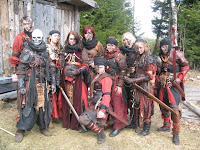
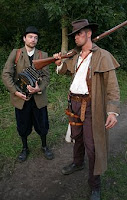 There are three breed of roleplayers out in the world which include
tabletop, video, and live action roleplayers. We have tabletop covered
and maybe someday we will get a Spooks video game made, but until then
Nathan Maher is also including rules for live action play which will be
included in the core rule book. Like with most larping game, props are
used which is why it is so easy to include live action rules into
Spooks. One of the reasons that makes the conversion so easy is that the
magic system of using cards already starts the player off with a way to
display when they are casting a spell. Dressing the part will be easy
for the most part since all undead type have human form and normal
Halloween masks and costume makeup will do. This is just another reason
to support this game.
There are three breed of roleplayers out in the world which include
tabletop, video, and live action roleplayers. We have tabletop covered
and maybe someday we will get a Spooks video game made, but until then
Nathan Maher is also including rules for live action play which will be
included in the core rule book. Like with most larping game, props are
used which is why it is so easy to include live action rules into
Spooks. One of the reasons that makes the conversion so easy is that the
magic system of using cards already starts the player off with a way to
display when they are casting a spell. Dressing the part will be easy
for the most part since all undead type have human form and normal
Halloween masks and costume makeup will do. This is just another reason
to support this game.See the Art Come to Life!
Check out the first video of the making of the artwork! Another video to come soon!
________________________________________________________________________
More updates to come on this post the sooner we get closer to our goals! So come back often, help support us by backing us on kickstarter and or sharing us on FB and Twitter . . . oh and now don't forget, enter the contest below to win free promotional posters.Poster Giveaway Contest!
We have a winner, Bjorn Bonten has just won all three posters and it will be mailed to him shortly. We will give notice if we hold another raffle!
We are holding a Rafflecopter Poster Giveaway. You can enter at this Link, like the page and then follow the directions. No purchase is needed, just need to do some actions such as comments, each day you can do more actions which earns points that improves your chances at winning!
These are the posters which you can win! Each are 18X24 quality print.
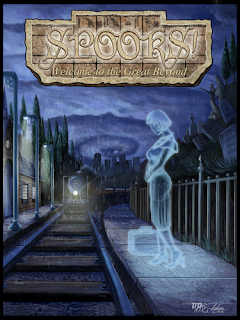
Labels:
afterlife,
bhoots,
contest,
dolls,
family fun,
game,
Ghosts,
kickstarter,
Lovecraft,
poster,
Roleplaying,
rpg,
skeletons,
spirits,
spooks,
Tabletop Role Playing Game,
undead,
vampires,
wraith,
zombies
Tuesday, May 14, 2013
Suggested Reading: Act 1
While I keep up with most technology, if only a step behind sometimes, I don't turn my back on older technology. Some say that print is dying these days and they might be correct, but books will always be around if not in a different form. Some say that you can find anything on the internet and while there is a lot of information on the web that can help you improve you artwork it won't always have all the answers. So it is always good to keep a good library of helpful books about technique and subject matter for you to refer to. With that in mind, here are some of my suggested readings and why to get them.
Framed Ink
Framed Ink is one of my go to books to understanding the tips and a tricks of creating a good composition and visual storytelling. The book is fully illustrated with good compositions which are then broken down into easy to understand visual shapes of those compositions. This is a must have book if you want to start learning to master composition.
A Glossary of Construction, Decoration & Use of Arms & Armor
It is always good to keep good reference material around and as an illustrator I need to be able to cover a lot of subjects. This book by George Cameron Stone is a great book for seeing a large variety of different weapons from throughout history and around the world. It has a ton of photo references from you to draw upon and it is an interesting read. If you do a lot of fantasy work then this is a great addition to your library.
Animal Anatomy for Artist: the Elements of Form
One of the hardest things an artist can master is to correctly draw the human form, but that is only because as humans we will pick at it more. Drawing the anatomy of animals is just as challenging. The book is fully illustrated with a wide variety of different animals, the structure of the bones, their muscle structure and different views to help an artist draw animals more realistically. The only draw back is that it doesn't cover reptile muscle structure, but it does cover birds and a wide variety of mammals. This is a must have and is well worth the cost.
So what is in your library? If anyone knows a good anatomy book that covers reptiles and shows their muscle structure I would love to know about it.
Framed Ink
Framed Ink is one of my go to books to understanding the tips and a tricks of creating a good composition and visual storytelling. The book is fully illustrated with good compositions which are then broken down into easy to understand visual shapes of those compositions. This is a must have book if you want to start learning to master composition.
A Glossary of Construction, Decoration & Use of Arms & Armor
It is always good to keep good reference material around and as an illustrator I need to be able to cover a lot of subjects. This book by George Cameron Stone is a great book for seeing a large variety of different weapons from throughout history and around the world. It has a ton of photo references from you to draw upon and it is an interesting read. If you do a lot of fantasy work then this is a great addition to your library.
Animal Anatomy for Artist: the Elements of Form
One of the hardest things an artist can master is to correctly draw the human form, but that is only because as humans we will pick at it more. Drawing the anatomy of animals is just as challenging. The book is fully illustrated with a wide variety of different animals, the structure of the bones, their muscle structure and different views to help an artist draw animals more realistically. The only draw back is that it doesn't cover reptile muscle structure, but it does cover birds and a wide variety of mammals. This is a must have and is well worth the cost.
So what is in your library? If anyone knows a good anatomy book that covers reptiles and shows their muscle structure I would love to know about it.
Labels:
animals,
armor,
art,
Books,
composition,
illustration,
reading,
Tobias White,
weapons
Thursday, April 25, 2013
Imagination, Inspiration, and Creative Blocks Part 2
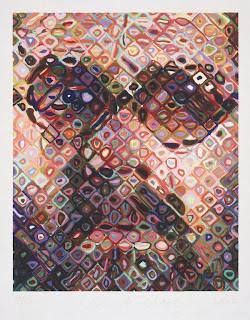 “Inspiration is for amateurs. The rest of us just show up and get to work. If you wait around for the clouds to part and a bolt of lightening to strike you in the brain, you are not going to make an awful lot of work. All the best ideas come out of the process; they come out of the work itself.”
“Inspiration is for amateurs. The rest of us just show up and get to work. If you wait around for the clouds to part and a bolt of lightening to strike you in the brain, you are not going to make an awful lot of work. All the best ideas come out of the process; they come out of the work itself.” Now while I do really appreciate the work that Chuck Close does, but I have to partially disagree with his quote. He is correct that you shouldn’t wait around for inspiration to spontaneously happen, but inspiration is a part of most art forms whether it be visual, musical, literary or even culinary because it is a part of the process. Inspiration is a process within the process of creating art and it is achieved through different methods of exploration.
Like in my last art blog article I am going to talk about various methods of how to gain inspiration, to flex you imagination or to unclog a creative blog. If you are interested in the prior methods I talked about you can find them here imagination-inspiration-and-creative part 1
Stop Thinking!

Thinking is overrated when you are trying to achieve something creative. Cognitive thought is only required for helping to solve problems you have not encountered in the past and it takes a lot of energy out of your system in the form of lowered glucose levels. By the time you are done “thinking” about what to do, your energy levels become lowered to the point where you loose the drive and ambition you had when you started the process. If you started the creative process by trying to solve too big of a problem you will find yourself trying to solve and almost impossible problem. Let go, start small, and draw upon what you already know and if that is not enough then go out and experience something new!
Visualize It!
This technique is similar to daydreaming but is more controlled. Michelangelo said, “ every block of stone has a statue inside it and it is the task of the sculptor to discover it” and all that we have to do is remove the excess stone. Michelangelo could see the statue in the stone before he sculpted his famous David statue. When you visualize what you want to achieve you are creating an actual long term memory. For years I have often did this naturally and when it occurred it was like I predicted the future. Then when you apply this visualization to other standard processes it is easier to achieve, with less work and greater success. However, visualization is not a short cut for prep work and when creating David, Michelangelo created many mock statues on a smaller scale after visualizing it to help with his process. By visualizing what you want to achieve and to put it into your long term memory you use less of your upper cognitive resources, so start picturing what you want to achieve before you begin work.
Play, Don’t Work!
 There is a big difference between work and play but both can be a productive or unproductive activity. Imagine back when you were a kid on the beach or in a sandbox and you started to build a sand castle or something similar. In its construction, you were in all probability very industrious in its creation but was it labor or play? I would argue, at the time of creation, that sand castle just felt like playing around despite the fact you put so much effort into it. When we play, while we might expend a lot of energy, we often don’t feel to tired even after play, but when we “work”, at a job that you may not like, you use up to many of your resources and become exhausted. When we play or minds are open and pliable but when we “work” our minds become closed and we rely to much on our cognitive minds if we are not use to that work. So, if you find that your current process has become to much of a chore it is a good idea to try and find a way to make it feel fun and a good way to do this is to make it like or similar to a game. If you are not having fun or you don’t even get satisfaction from what you are doing then that task is not really worth doing over and over again, there is no point.
There is a big difference between work and play but both can be a productive or unproductive activity. Imagine back when you were a kid on the beach or in a sandbox and you started to build a sand castle or something similar. In its construction, you were in all probability very industrious in its creation but was it labor or play? I would argue, at the time of creation, that sand castle just felt like playing around despite the fact you put so much effort into it. When we play, while we might expend a lot of energy, we often don’t feel to tired even after play, but when we “work”, at a job that you may not like, you use up to many of your resources and become exhausted. When we play or minds are open and pliable but when we “work” our minds become closed and we rely to much on our cognitive minds if we are not use to that work. So, if you find that your current process has become to much of a chore it is a good idea to try and find a way to make it feel fun and a good way to do this is to make it like or similar to a game. If you are not having fun or you don’t even get satisfaction from what you are doing then that task is not really worth doing over and over again, there is no point.Now of course, I don’t claim to know all there is to know about being creative, but I do try to communicate what I do know on to others. I am also very interested in knowing what you all thinking about being creative and would love to hear from you all.
Wednesday, April 17, 2013
Imagination, Inspiration, and Creative Blocks Part 1
An artist’s greatest tool is having a strong imagination, but it is like a muscle and if it does not get regular exercise then it can atrophy. However, not everyone know’s how to get inspired and even the best creative minds get creative blocks. So I am going to share some of my tips of when I need inspiration or when I get a block that needs unclogging.
Get Distracted and Letting Go
Creative blocks are often due to the trap of holding onto an idea like an mistreated pit bull. You have convinced yourself that your initial idea is the only possible avenue and thus you have created a sort of tunnel vision keeping you from seeing other possibilities. When this happens, the best suggestion I can make is to walk away from what you are doing and get your mind off the subject. Until you can let go of your initial idea you won’t be able to come up with new ones. A good way to get distracted is to go take a walk or go ride a bicycle. Albert Einstein, a champion of imagination, often stated to go on a bicycle ride to remove blocks. However, getting chores or errands out of the way also helps remove the tunnel vision. Lastly anything that lets you relax and take your mind off things allow you to approach a problem with fresh eyes.
Daydreaming
“Bobby, stop daydreaming and pay attention!”
Sadly our society today has often frowned on the daydreamers, because it doesn’t seem to be evidently productive. However, I disagree and I willing to bet that most creative minds out in the world today will agree with me that it can be one of the more productive initial methods in creative work. Daydreaming is an excellent method in exploring new ideas, because when we daydream it is our own private world where we can shed our hangups, where we are not judged for looking foolish and we can mentally play in any shape or form. Daydreaming, is the ultimate form of brainstorming because it is like writing a movie script that we can quickly rewind, fast forward and edit as we go along. Lastly daydreaming starts off small with a simple idea and it lets you evolve it into a more complex idea that seems more natural and intuitive.
Take the Risk!
 The whole attitude that “it will never work” is a bad block to brainstorming. When brainstorming ideas it is generally a good idea not to automatically discount what you may deem to be an bad or unpopular idea. It is better to lay that idea out there whether it be a fast sketch or a short little line. Even if the idea might not be sound, the idea still may provide a path to a new idea. Also, never be afraid to do something because it has or has not been done before. If it hasn’t been done before then odds are you will grab some kind of audience and if it has been done before then you might be able to put a new spin on it. Desi Arnaz, also known as Ricky Ricardo from the “I Love Lucy Show” was famous for taking risks that no one was willing to try merely because it had never been done before and made it a success.
The whole attitude that “it will never work” is a bad block to brainstorming. When brainstorming ideas it is generally a good idea not to automatically discount what you may deem to be an bad or unpopular idea. It is better to lay that idea out there whether it be a fast sketch or a short little line. Even if the idea might not be sound, the idea still may provide a path to a new idea. Also, never be afraid to do something because it has or has not been done before. If it hasn’t been done before then odds are you will grab some kind of audience and if it has been done before then you might be able to put a new spin on it. Desi Arnaz, also known as Ricky Ricardo from the “I Love Lucy Show” was famous for taking risks that no one was willing to try merely because it had never been done before and made it a success.
Make a List of Nouns!
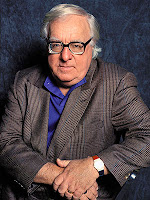 One of my favorite authors, Ray Bradbury, once said that he likes to make a list of nouns for inspiration of what he wanted to write about; the same could be applied to visual artists as well. The idea behind this strategy is to start small or simple so that you have something to build around. Any idea needs a strong foundation before you can build it into something grand. If one tries to create a complex idea right off the start then odds are the idea will not communicate well. For example, I start with the idea I want to do a painting about friendship, this is the core idea, how can I show that, what are some of the actions that friends do, what kind of moods do I want for this act of friendship, and so on and so on.
One of my favorite authors, Ray Bradbury, once said that he likes to make a list of nouns for inspiration of what he wanted to write about; the same could be applied to visual artists as well. The idea behind this strategy is to start small or simple so that you have something to build around. Any idea needs a strong foundation before you can build it into something grand. If one tries to create a complex idea right off the start then odds are the idea will not communicate well. For example, I start with the idea I want to do a painting about friendship, this is the core idea, how can I show that, what are some of the actions that friends do, what kind of moods do I want for this act of friendship, and so on and so on.
Tune in!
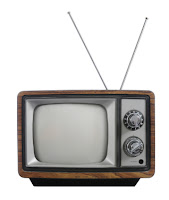 A great way to get inspired to do something creative is to be inspired by the works of other creative people. These days we are inundated with a barrage of different forms of mediums that convey the collective of our creative minds. Often, I was inspired by a book, a painting, a song, a TV program, a movie, or even a video game to create something creative or interesting. Now a common reaction to this notion is that, “well you are just copying something you saw”, but this is not necessarily the case. When exposed to these mediums it is easy for one to be inspired by the smallest fragment of what you saw, read or heard. This small fragment may have just been a small interesting detail in the original medium, but was not the original idea. Another possibility is that you were inspired by the original idea, but you start to daydream and play the what if game allowing you to put a new spin on the original idea. Remember, as long as you change an idea enough and make it your own taking ideas from others is not stealing. Imagination is not an internal force, but rather it is a reflection and multi-faceted projection of our experiences and knowledge. We take in information from the world around us and intuitively re-order it into something new. Something is not created from nothing but simply transformed from what was before.
A great way to get inspired to do something creative is to be inspired by the works of other creative people. These days we are inundated with a barrage of different forms of mediums that convey the collective of our creative minds. Often, I was inspired by a book, a painting, a song, a TV program, a movie, or even a video game to create something creative or interesting. Now a common reaction to this notion is that, “well you are just copying something you saw”, but this is not necessarily the case. When exposed to these mediums it is easy for one to be inspired by the smallest fragment of what you saw, read or heard. This small fragment may have just been a small interesting detail in the original medium, but was not the original idea. Another possibility is that you were inspired by the original idea, but you start to daydream and play the what if game allowing you to put a new spin on the original idea. Remember, as long as you change an idea enough and make it your own taking ideas from others is not stealing. Imagination is not an internal force, but rather it is a reflection and multi-faceted projection of our experiences and knowledge. We take in information from the world around us and intuitively re-order it into something new. Something is not created from nothing but simply transformed from what was before.
Now I don’t ever claim to know all there is to being creative or how to unclog a creative block. I am sure many of you out there have tips & tricks of how to be inspired or to stop creative blocks and I invite you all to contribute. Also please feels free to ask any questions you have and I will do my best to answer them.
Get Distracted and Letting Go
Creative blocks are often due to the trap of holding onto an idea like an mistreated pit bull. You have convinced yourself that your initial idea is the only possible avenue and thus you have created a sort of tunnel vision keeping you from seeing other possibilities. When this happens, the best suggestion I can make is to walk away from what you are doing and get your mind off the subject. Until you can let go of your initial idea you won’t be able to come up with new ones. A good way to get distracted is to go take a walk or go ride a bicycle. Albert Einstein, a champion of imagination, often stated to go on a bicycle ride to remove blocks. However, getting chores or errands out of the way also helps remove the tunnel vision. Lastly anything that lets you relax and take your mind off things allow you to approach a problem with fresh eyes.
Daydreaming
“Bobby, stop daydreaming and pay attention!”
Sadly our society today has often frowned on the daydreamers, because it doesn’t seem to be evidently productive. However, I disagree and I willing to bet that most creative minds out in the world today will agree with me that it can be one of the more productive initial methods in creative work. Daydreaming is an excellent method in exploring new ideas, because when we daydream it is our own private world where we can shed our hangups, where we are not judged for looking foolish and we can mentally play in any shape or form. Daydreaming, is the ultimate form of brainstorming because it is like writing a movie script that we can quickly rewind, fast forward and edit as we go along. Lastly daydreaming starts off small with a simple idea and it lets you evolve it into a more complex idea that seems more natural and intuitive.
Take the Risk!
 The whole attitude that “it will never work” is a bad block to brainstorming. When brainstorming ideas it is generally a good idea not to automatically discount what you may deem to be an bad or unpopular idea. It is better to lay that idea out there whether it be a fast sketch or a short little line. Even if the idea might not be sound, the idea still may provide a path to a new idea. Also, never be afraid to do something because it has or has not been done before. If it hasn’t been done before then odds are you will grab some kind of audience and if it has been done before then you might be able to put a new spin on it. Desi Arnaz, also known as Ricky Ricardo from the “I Love Lucy Show” was famous for taking risks that no one was willing to try merely because it had never been done before and made it a success.
The whole attitude that “it will never work” is a bad block to brainstorming. When brainstorming ideas it is generally a good idea not to automatically discount what you may deem to be an bad or unpopular idea. It is better to lay that idea out there whether it be a fast sketch or a short little line. Even if the idea might not be sound, the idea still may provide a path to a new idea. Also, never be afraid to do something because it has or has not been done before. If it hasn’t been done before then odds are you will grab some kind of audience and if it has been done before then you might be able to put a new spin on it. Desi Arnaz, also known as Ricky Ricardo from the “I Love Lucy Show” was famous for taking risks that no one was willing to try merely because it had never been done before and made it a success.Make a List of Nouns!
 One of my favorite authors, Ray Bradbury, once said that he likes to make a list of nouns for inspiration of what he wanted to write about; the same could be applied to visual artists as well. The idea behind this strategy is to start small or simple so that you have something to build around. Any idea needs a strong foundation before you can build it into something grand. If one tries to create a complex idea right off the start then odds are the idea will not communicate well. For example, I start with the idea I want to do a painting about friendship, this is the core idea, how can I show that, what are some of the actions that friends do, what kind of moods do I want for this act of friendship, and so on and so on.
One of my favorite authors, Ray Bradbury, once said that he likes to make a list of nouns for inspiration of what he wanted to write about; the same could be applied to visual artists as well. The idea behind this strategy is to start small or simple so that you have something to build around. Any idea needs a strong foundation before you can build it into something grand. If one tries to create a complex idea right off the start then odds are the idea will not communicate well. For example, I start with the idea I want to do a painting about friendship, this is the core idea, how can I show that, what are some of the actions that friends do, what kind of moods do I want for this act of friendship, and so on and so on.Tune in!
 A great way to get inspired to do something creative is to be inspired by the works of other creative people. These days we are inundated with a barrage of different forms of mediums that convey the collective of our creative minds. Often, I was inspired by a book, a painting, a song, a TV program, a movie, or even a video game to create something creative or interesting. Now a common reaction to this notion is that, “well you are just copying something you saw”, but this is not necessarily the case. When exposed to these mediums it is easy for one to be inspired by the smallest fragment of what you saw, read or heard. This small fragment may have just been a small interesting detail in the original medium, but was not the original idea. Another possibility is that you were inspired by the original idea, but you start to daydream and play the what if game allowing you to put a new spin on the original idea. Remember, as long as you change an idea enough and make it your own taking ideas from others is not stealing. Imagination is not an internal force, but rather it is a reflection and multi-faceted projection of our experiences and knowledge. We take in information from the world around us and intuitively re-order it into something new. Something is not created from nothing but simply transformed from what was before.
A great way to get inspired to do something creative is to be inspired by the works of other creative people. These days we are inundated with a barrage of different forms of mediums that convey the collective of our creative minds. Often, I was inspired by a book, a painting, a song, a TV program, a movie, or even a video game to create something creative or interesting. Now a common reaction to this notion is that, “well you are just copying something you saw”, but this is not necessarily the case. When exposed to these mediums it is easy for one to be inspired by the smallest fragment of what you saw, read or heard. This small fragment may have just been a small interesting detail in the original medium, but was not the original idea. Another possibility is that you were inspired by the original idea, but you start to daydream and play the what if game allowing you to put a new spin on the original idea. Remember, as long as you change an idea enough and make it your own taking ideas from others is not stealing. Imagination is not an internal force, but rather it is a reflection and multi-faceted projection of our experiences and knowledge. We take in information from the world around us and intuitively re-order it into something new. Something is not created from nothing but simply transformed from what was before.  |
| Imagination can even defeat the Boogieman |
Tuesday, March 26, 2013
The Art of Critiquing
There is an art to the critique, but over the years I have learned that most people have many misconceptions of how a critique should be given or received. It took me a while to learn the art of a good critique, but over many years of school and critiquing sessions, I felt it would be a good idea to share what I have learned. Lastly, it is my intent for this article to be able to work for any medium whether it be the visual arts, music, writing, culinary, performing arts or even a worker's performance in day to day life.
So, what should a critique be? This might seem like a silly question, but I have found that many people confuse a critique with a criticism. This leads many critiques to often tear down the person receiving the critique, when in fact they wanted some constructive feedback so that they can improve. When someone asks for a critique, they are either asking for a pat on the back, how they can improve or a bit of both. Over the decades it has long been debated in our school system whether it is better to use negative or positive reinforcement. The truth of the matter is that both methods have their merits, but alone they can cause damage. Keeping this in mind, when giving a critique, it is best to give both the pros and the cons. Focusing just on the positive can make the recipient misunderstand the intent of the critique such as: the artist thinks he/she is a professional level artist or that the critic is being insincere. Equally if the critique focuses just on the negative then that artist might end up changing something that was good, especially if there were a lot of negative points, or that artist might even give up all together because of feeling a loss of worth.
A better approach to a critique, is to apply both positive and negative reinforcement. With this approach, the person receiving the critique will be more receptive to the areas that need improvement and in a addition they are more likely to keep the aspects of their work that were successful. Some might argue that this is to avoid hurt feelings, but this is not the case, it is about good communication between the critic and the receiver which in turn will lead to a positive outcome.
There are somethings that a critic should and should not do. A critic should not try to point out a problem if they have no knowledge or experience in that given area, because this will provide bad feedback for the person on the receiving end of the critique. If the critic does detect a problem through intuition, but it is beyond their experience then stating the problem area is acceptable, but it must be pointed out that he/she doesn't have the exact knowledge of what is wrong. If the critic is not only an expert, but is skilled as well, then the critic should explain how to correct what is pointed out. Such an explanation is a courtesy, but is more constructive than without. The critic, however should not be obligated as to the length of such an explanation, if the critic feels any explanation is needed. It is good form to provide additional explanation or help if the receiver requests such information, but again this is not an obligation.
While I have stated that a balanced critique is one that provides both positive and negative feedback, sometimes this is harder said than done. If as the critic, you can't find any positive thing to say about the receiver's technique and skill, then pointing out the concept of what they were trying to achieve in a positive light can help. If the receiver shows they made a lot of effort in the work they did, then acknowledging that effort can help. If as the critic you can't find any negative feedback then try following up with alternative ideas that fit within the intent of the receiver's work because this might inspire them to reach higher than their current ability.
The receiver of a critique also needs to understand how to receive a critique with grace. First the receiver should keep quite until the critique is finished and to not be quick to defend. In fact, the receiver should not try to defend their work at all, because most of the time they asked for the critique. After the critique is given the receiver may and probably should explain what their intent was in the work that is up for critique. Sometimes this may be given before a critique and it really depends on the protocol that has been established in a session. When the intent is communicated then the critic will understand better and will offer better feedback. This is often needed because the intent is not always apparent. It is good to get critiques from different sources for the same work, because if there are overlapping comments then odds are good that they know what they are talking about. If the receiver feels that the critic is in error then that is fine, but it is bad form to call them out. If the critique is given online then it is fine to check out their work if the receiver needs that validation if the all or part of the critique was thought to be in error due to non-experience; don't accept the talk if they can't walk the walk.
Remember, a critique is not about criticizing, but it is about communication and constructive feedback to help the receiver of the critique improve their skills and knowledge. Hopefully I have covered what makes a good and balanced critique, but life can always throw you a surprise, so please feel free to ask any questions you may have and I will answer it to the best of my ability.
Friday, March 22, 2013
Arkham: A nice place to Visit: My process
Ever since Mike Davis was kind enough to show my War of the Worlds Vs Cthulhu composition on his website Lovecraft Ezine and on his corresponding Facebook Page it has been getting more coverage than I have ever had before. So I thought it would be a good idea to share a little bit about the process I took in creating it as well as my other art.
However, before I get to my process I will share a detail that doesn't show up well on the versions that I have up on the internet for viewing. First there is a lot more detail to Cthulhu and second is the billboard advertisement for the fictional Arkham City. While this doesn't show up in most of the web versions, it does show up well on a full size print which can be bought through Zazzle or Deviant Art which you can get to via the page tabs above.



The first step I took when planning this composition is working up some quick thumbnail sketches in Photoshop. The ratio size of these thumbnail sketches are in direct proportion to the size of the canvas that I desired for the final piece. I already had a good idea of what I wanted, because I had visualized it in a dream, so the changes are minor in the variations for these thumbs, but often this process is a brain storming session, because while at times I might have started off with a small seed of an idea, thumbing may allow it to grow into anything. Mostly what I was looking for was positioning and poses for the primary and secondary foci of this composition. To help me with placement I used my golden ratio overlay tools. You can find out more about that on my Golden-Compositions post. After finding the general positioning and poses that I like, I then add in more content with a few more thumbnails for a more complete composition.
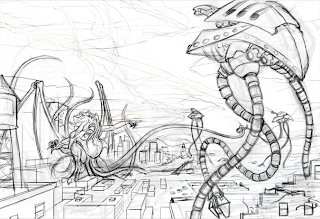 After I choose the final thumbnail sketch I scale this rough sketch up to a large size canvas and refine the sketch more. During this sketch I am looking for a tighter drawing so my concerns are about proper perspective and form since I don't have to worry about the compositional placement anymore. I also add in more details, but I keep these details loose because I don't want to obsess about it; this is a easy trap to fall into and I try to avoid it at all costs. I sketch right into Photoshop via my Wacom tablet and I do so on a transparent layer because this allows me to paint underneath my sketch so that I can keep my drawing separate from my painting, because the last thing you want to do is be destructive to the work you have already done.
After I choose the final thumbnail sketch I scale this rough sketch up to a large size canvas and refine the sketch more. During this sketch I am looking for a tighter drawing so my concerns are about proper perspective and form since I don't have to worry about the compositional placement anymore. I also add in more details, but I keep these details loose because I don't want to obsess about it; this is a easy trap to fall into and I try to avoid it at all costs. I sketch right into Photoshop via my Wacom tablet and I do so on a transparent layer because this allows me to paint underneath my sketch so that I can keep my drawing separate from my painting, because the last thing you want to do is be destructive to the work you have already done.
Painting now begins and I start off lowering the opacity of my sketch to around 30% and then lock the layer. I then create a new layer under this and begin painting the local colors I want for all my objects. Sometimes, I will go back and change this as needed. Your local colors are the true color of your objects but they will be effected by the temperature of light and shadow later and so will look very different later on. The only exception I made here was the sky. When I paint skies I just let my intuition take over and taking logic out of the process because doing skies I find to be an abstract experience.
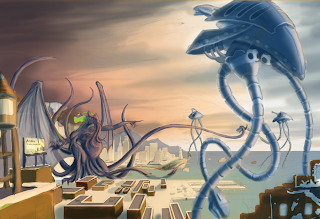
When finished with that I lock my local color layer and then create two new layers over this to start working in light and shadow. One layer is set to multiply at a lower opacity and soft light on the other. To know more about this process you can check out this other article I wrote called color-blending-fx-brushing-and-photos which not only explains the process but also includes video tutorials I have created.
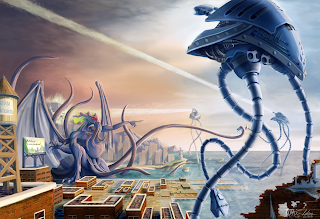
Now that I have color and value down close to what I want, I create merged copy layer of what I have created so far and paint directly on that; this way my canvas becomes my pallet and I don't have to worry about using color swatches. I then clean up and make alteration to color as I think it needs it. I also starting laying in some base texture as a starting point for texture and details. I use these textures merely as a starting point and guide and I paint over this to fit the painting. If you would like to know more about textures then you might check out my texture-hunter part 1.
My last step is to bring the painting home, which generally means that I continue painting in refinements, textures and details. The very last effort I made on this painting was to make one more merged copy of the work I had so far and rotated the image a few degrees for a dutch angle to create some mood but the reason I only did this a little bit because I didn't want to throw my compositional placement off. If I find that I cannot figure out what more to do or if I am getting fussy over the painting I walk away from the painting for several hours and then come back to it with fresh eyes.
So I hope you found this interesting and helpful and would be glad to answer any questions so feel free to ask them in the comment box.
Sunday, March 3, 2013
Golden Compositions
Golden Compositions
Most artists have heard of the golden ratio or rule of two-thirds, but not every artist know all the different variations let alone how to use such mathematical tools. In this article I will go over these various tools of Phi and my interpretation on how to and when to use them. Also for the digital artists I have included these files to be transparent PNGs that can easily be adjusted to the area of what ever size canvas you may be working on because when stretch or squashed it will keep the ratio in relation to your canvas, allowing for a quick compositional grid overlay.
The Golden Ratio
The golden ratio is is a grid divided into thirds, with the middle rows being half the size of one of the out rows but when the outer rows are added to the middle then the total length and width are attained in a balanced mathematical proportion with a ratio of 1.68. To use this grid in art, one simply needs to place the focal point of their composition on and around one or more of the intersections of the grid. Another option is to the columns for placement. If one used the center then one can create a power focus but such focus needed only when the subject is overwhelm the audience. For instance the statue of liberty or the Monolith from 2001 space Odyssey.
The Rule of Two-Thirds
This is the cousin of the Golden Ratio and it is used exactly the same way with just a little different placement as the area of the piece is divided equally into thirds.
The Golden Triangle
The Golden Triangle is a little different than the ratios and the point of using this tool is for directional line or for placement that breaks up the piece into thirds. If used for directional line the focal points line up and the intersection and spread out but for placing the images into thirds then one to two of the triangles will contain your focal points but it is best to do this on separate planes.
The Golden Spiral
The bottom one is the one with the transparency
The Golden Spiral is about placement and flow of the picture to help guide the eye of the viewer around the picture plane. This is a powerful grid and it is a form of fractal that can be found all through out nature. From studying various strong compositions and other articles about this tool I can tell you that it is the hardest one to follow, but I hope my understanding will make it clear you you all. The grid itself is based on the golden ratio but it can definitely spiral tighter and tighter and it keeps breaking down . Inside these sections you can place your main focal points of your composition as long as they remain for the most part of the inside track of the spiral that is formed from the cornered points. Secondary focal points can be created by placing them as an intersection along this spiral path which will create flow and guide the eye around your composition.
Down Below are examples of my artwork that show how these grids work for strong compositions.
Also it is important to note that you don't have to limit your self to just one of these tools or the multiple use of the same tool but with different orientation with the only proviso that you do not distort the ratios.
I have included one more transparent ratio grid and that is a master grid that gives all possible orientation, but I would advise starting off with these separately until you understand how they work before trying to use them all at once.
Lastly if you have any questions please feel to ask and I will answer them the best I can. Also I don't claim total knowledge in how the golden ratio can be used and I feel that there are many different methods in using it so if you know something I don't then please share with a comment.
Subscribe to:
Posts (Atom)



























